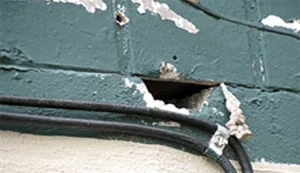
Rats can be a common nuisance in many neighborhoods, causing damage to property and spreading diseases. If you're dealing with a rat problem in your backyard, it's essential to take action to keep these pesky rodents away. In this article, we'll explore effective strategies to help you keep rats out of your backyard and maintain a rat-free environment.
Having a rat infestation in your backyard can be a nuisance and a health hazard. Fortunately, there are several strategies you can implement to keep rats away. In this article, we will explore some natural rat repellents, motion-activated devices, and outdoor rat traps that can help you regain control of your backyard.

Gardening enthusiasts will be pleased to know that certain plants can help deter rats from entering your backyard. Peppermint, for example, is known for its strong smell that rats find repulsive. Planting peppermint around your yard or in pots near entrances can help keep rats at bay. Not only does peppermint serve as a natural rat repellent, but it also adds a refreshing aroma to your garden.
In addition to peppermint, other rat-repellent plants include lavender, rosemary, and sage. These plants not only add beauty to your garden but also serve as a natural barrier against rats. Lavender, with its vibrant purple flowers, emits a scent that rats find unpleasant. Rosemary, with its aromatic leaves, acts as a deterrent for rats. Sage, with its distinct fragrance, can help keep rats away from your backyard.
By incorporating these rat-repellent plants into your garden, you create an environment that is uninviting to rats. Not only will you have a beautiful and fragrant garden, but you will also have peace of mind knowing that your backyard is protected from rat infestations.
If you prefer a more hands-off approach to rat control, motion-activated devices can be an effective tool. These devices emit high-frequency sounds and vibrations, which rats find disruptive and unpleasant. By strategically placing motion-activated devices around your yard, you can create an environment that rats will want to avoid.
When choosing motion-activated devices, opt for ones specifically designed for rat control. These devices are equipped with sensors that detect the movement of rats and trigger the emission of high-frequency sounds and vibrations. Some devices even have adjustable settings, allowing you to customize the frequency and intensity of the deterrent effect.
In addition to motion-activated devices, consider using solar-powered lights in your backyard. These lights not only provide illumination but also have a deterrent effect on rats during nighttime. Rats are naturally nocturnal creatures, and the presence of well-lit areas can make them feel exposed and vulnerable, discouraging them from entering your backyard.
Rat traps remain one of the most common and effective methods for rat control. When setting outdoor rat traps, it's important to do so strategically to maximize their potential. Identify areas where rats are likely to frequent, such as near garbage bins or under decking.

Before setting the traps, make sure to bait them with enticing food that rats cannot resist. Peanut butter and dried fruits are popular choices as they have strong smells that attract rats. Place a small amount of bait on the trap's trigger to entice the rat to step on it.
When setting outdoor rat traps, it's crucial to prioritize safety. Choose traps that are designed to capture rats without harming them. This ensures the safety of other animals or children that may come into contact with the traps. Set the traps in secure locations, away from areas where pets or children may accidentally trigger them.
Regularly check and reset the traps to increase the chances of successful rat removal. Rats are intelligent creatures and may become wary of traps after witnessing their peers getting caught. By consistently monitoring and resetting the traps, you maintain their effectiveness in controlling the rat population in your backyard.
In conclusion, keeping rats out of your backyard requires a multi-faceted approach. By incorporating natural rat repellents, motion-activated devices, and outdoor rat traps, you can create an environment that is uninviting to rats. Remember to choose methods that prioritize safety and regularly maintain them for optimal results. With these effective strategies, you can enjoy a rat-free backyard and peace of mind.
When it comes to rat control, prevention is key. By taking proactive measures to keep rats out of your backyard, you can avoid the hassle and potential health risks associated with rat infestations. In this guide, we will walk you through four important steps to help you effectively prevent and remove rats from your property.
Before you can effectively prevent rats from entering your backyard, it's important to identify the potential entry points they may use. Take a thorough look around your property and pay close attention to any holes in fences, gaps in doors or windows, and cracks or crevices that rats can squeeze through. By carefully inspecting your backyard, you can pinpoint the areas that require immediate attention.
Additionally, it's worth noting that rats are excellent climbers and can easily access your property through overhanging tree branches or vines. Keep an eye out for any vegetation that may be providing easy access to your backyard and consider trimming or removing it to make it less inviting for rats.

Once you've identified the entry points, it's crucial to take action and seal them off. Rats can squeeze through incredibly small openings, so it's important to use materials that they cannot easily chew through. Steel wool or wire mesh are excellent options for covering holes or gaps in fences, doors, or windows. Pay extra attention to utility entrances, such as plumbing or electrical openings, as rats can exploit these vulnerable points.
Remember, rats are persistent creatures, so it's important to be thorough in your exclusion efforts. Take the time to carefully inspect your property and address any potential access points. By making it difficult for rats to find a way into your backyard, you significantly reduce the likelihood of future rat encounters.
If you've had a rat problem in your backyard, it's important to not only prevent future infestations but also to clean and sanitize the affected areas. Rat droppings, urine, and nests can harbor harmful bacteria and viruses, posing a potential health risk to you and your family.
When cleaning rat-infested areas, it's essential to take proper precautions. Wear gloves and a mask to protect yourself from direct contact with potentially contaminated materials. Use a disinfectant solution to thoroughly clean surfaces and remove any traces of rat activity. It's also important to remove any potential food sources, such as fallen fruits or unsecured garbage cans, as these can attract rats and increase the likelihood of future infestations.
Preventing rats from entering your backyard requires ongoing effort and maintenance. Regularly inspect your property for new entry points and address them promptly. Keep your yard clean and tidy, ensuring that garbage is properly secured in rat-proof containers. By eliminating potential food sources and maintaining a clutter-free environment, you make your backyard less attractive to rats.
In addition to regular inspections and cleanliness, it's important to trim shrubs and trees regularly. Overgrown vegetation can provide hiding places and easy access points for rats. By keeping your landscaping well-maintained, you eliminate potential hiding spots and make it more difficult for rats to infiltrate your property.
By following these four steps - inspection, exclusion, restoration, and prevention - you can effectively prevent and remove rats from your backyard. Remember, a proactive approach is key to maintaining a rat-free environment. Stay vigilant, take preventive measures, and enjoy a backyard that is free from these unwanted pests.
If you've tried various rat control methods but still find yourself dealing with persistent rat problems, it may be time to consider professional rat removal services. Experienced pest control experts can assess your backyard, identify potential infestation sources, and develop a customized rat control plan. They have the knowledge and tools to effectively remove rats from your property while ensuring the safety of your family and pets.
When it comes to rat control, it's important to trust the experts. Rats can be elusive creatures, often hiding in hard-to-reach areas of your property. Professional rat removal services have the expertise to locate these hiding spots and implement targeted strategies to eliminate the infestation. They understand the behavior and habits of rats, allowing them to develop effective and long-lasting solutions.
One of the advantages of hiring professional rat removal services is their ability to conduct a thorough inspection of your backyard. They will carefully examine your property, looking for signs of rat activity such as droppings, gnaw marks, and burrows. By identifying these indicators, they can determine the extent of the infestation and devise a plan to eradicate the rats.
Once the inspection is complete, the pest control experts will develop a customized rat control plan tailored to your specific needs. This plan may include a combination of trapping, baiting, and exclusion techniques. Traps will be strategically placed in areas where rats are likely to travel, ensuring maximum effectiveness. Bait stations will be used to lure rats and eliminate them safely. Additionally, the experts may recommend sealing off entry points and making necessary repairs to prevent future infestations.
Professional rat removal services prioritize the safety of your family and pets. They use environmentally friendly and humane methods to remove rats from your property. These experts are trained in the proper handling and disposal of traps and baits, minimizing any potential risks. They will also provide you with guidance on how to maintain a rat-free environment after the removal process.
Don't let rats take over your backyard. By implementing these effective strategies and taking proactive measures, you can keep rats at bay and enjoy a peaceful and rat-free outdoor space. Remember, professional rat removal services are just a phone call away. Trust the experts to handle your rat control needs and regain control of your property.